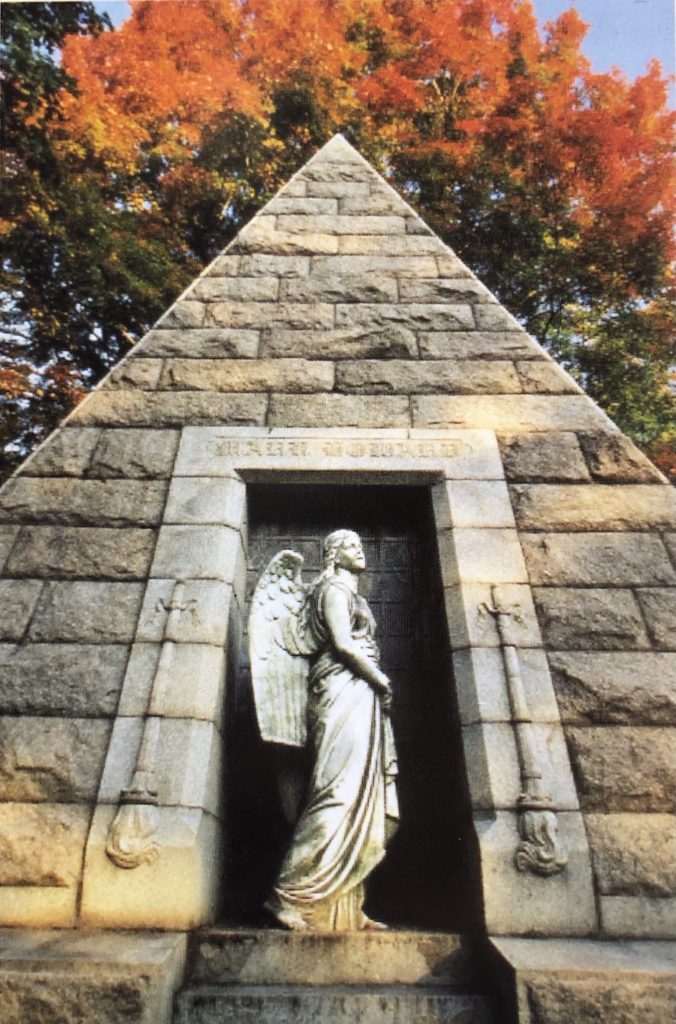By Irene McHugh
(c) Connecticut Explored Inc. SUMMER 2005
Subscribe/Buy the Issue!
Travel south on Fairfield Avenue in Hartford and you’ll arrive at what could be considered one’s “final” destination—Cedar Hill Cemetery. But Cedar Hill is more than just a resting place for the deceased–life is celebrated here and Cedar Hill offers visitors an experience that includes art, history, and nature.
Established in 1864 as part of the American rural cemetery movement, Cedar Hill’s mission was to “provide a place of sepulchre in harmony with the promise of rest and peace for the dead, satisfactory to the most cultivated taste of the living and made forever secure as a sacred trust in the care of a perpetual corporation.” The rural cemetery movement, which flourished in America from 1831 when Mount Auburn Cemetery in Cambridge, Massachusetts was developed to the early 1900s, reflected the physical realities and social thinking of its time. By the early 19th century, Colonial-era burying grounds and churchyards were becoming crowded and, as the century progressed, attitudes about what constituted a proper burial changed. Victorian social attitudes also dictated that a cemetery should serve a larger purpose beyond a place for interment. A rural cemetery—even when located in the city—should satisfy the living by being “a vast temple to the transcendent being where the visitor senses the eminence of God in nature.”
By the summer of 1863, it was clear that Hartford needed a place of burial that met these requirements. A site to the city’s south, large enough to provide for the needs of future generations without danger of encroachment, was chosen. Construction began in the fall of 1865 under the supervision of the pioneer landscape architect Jacob Weidenmann, who had earlier designed Hartford’s Bushnell Park. Weidenmann’s innovative “open lawn” plan, with unbroken vistas and gently curving roadways, became the guiding principle for his book, Modern Cemeteries, published in 1888. Modern Cemeteries went on to become the leading authority on cemetery development in America.
Today, Cedar Hill Cemetery is situated on 270 secluded acres of woodlands, fields, and ponds that attract a wide variety of wildlife. Its, burial sections contain more than 2,000 large trees, a number of them state champions. Many of the imposing monuments were designed and executed by well-known 19th-century architects and artists, and the list of notable “residents” comprises the elite of Hartford’s Gilded Age and others: gun manufacturers Sam and Elizabeth Colt, Twain’s Nook Farm companions Reverend Joseph Twichell, General Joseph Roswell Hawley, early feminist Isabella Beecher Hooker, Hartford Courant editor Charles Dudley Warner, discoverer of anesthesia Horace Wells, financier J.P. Morgan, poet Wallace Stevens and, most recently, the incomparable Katharine Hepburn, who once said “it’s. . . nice . . . to have a place to come back to . . . where there’s even a piece of ground waiting for you. And your own dear ones. A place where you know the gravestones and the trees and the flowers and you’ll go in that old gate on Fairfield Avenue . . .”
Although momentous changes have occurred in the surrounding city since Cedar Hill’s creation, the cemetery has remained a constant source of solace and beauty, providing a unique testament to its founders’ faith that this place would endure for future generations.
Visitors are welcome daily from 7 a.m. to dusk. From May through October, Cedar Hill sponsors tours and events that include a walking tour commemorating exceptional women, a costumed presentation on death and mourning in the 19th century, a Civil War event, and a haunted history Halloween tour. For more information, call (860) 956-3311 or visit Cedar Hill’s Web site at www.cedarhillcemetery.org.
Explore!
“The Height of Fashion in Funerary Art,” Fall 2021
“Grave Deeds and Abandoned Cemeteries,” Summer 2019
Hartford’s Ancient Burying Ground: “Unburying Hartford’s Native and African Family Histories,” Fall 2019
“Beauty in a Gravestone” Winter 2010/2011
“Benjamin Collins, Rock Star,” Spring 2015
Read stories about Notable Connecticans on our TOPICS page.

